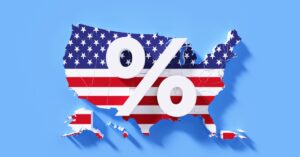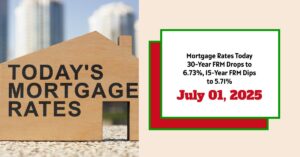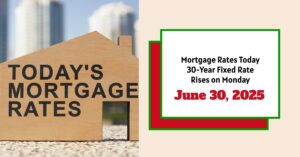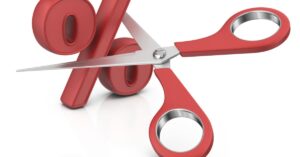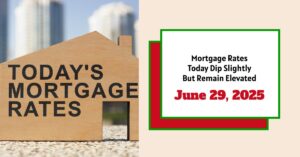Looking for the best mortgage rates? As of today, July 1, 2025, the states offering the cheapest 30-year new purchase mortgage rates are New York, California, New Jersey, Colorado, Connecticut, Florida, and Utah, with averages ranging from 6.56% to 6.72%.
On the other end of the spectrum, the states with the highest refinance rates are Alaska, West Virginia, New Mexico, Mississippi, Nebraska, Rhode Island, and Hawaii, averaging between 6.83% and 6.94%. Let's dive deeper into why these differences exist and what it means for you as a potential homebuyer or refinancer.
U.S. States With Lowest and Highest Mortgage Rates Today – July 1, 2025
Before we continue, I want to just stress importance of doing your own research and consulting professional mortgage lenders to figure out the best option for you.
Why Do Mortgage Rates Vary So Much by State?
It's frustrating, I know. You see a low advertised rate, but when you start looking in your state, it's a completely different story. So, what gives? Several factors contribute to these state-by-state variations:
- Different Lenders, Different Regions: Not all lenders operate in every state. The competitive landscape varies, and some lenders may specialize in certain regions. Greater competition often translates to better rates.
- Credit Score Variations: The average credit score of borrowers can differ across states. States with higher average credit scores might see slightly lower rates overall.
- Average Loan Size: The typical mortgage amount can vary significantly. Lenders might adjust rates based on the risk associated with smaller or larger loan sizes.
- State Regulations: Mortgage lending is subject to both federal and state regulations. More stringent regulations can sometimes impact rates, either positively or negatively.
- Lender Risk Management: Each lender has its unique approach to assessing and managing risk. This includes their comfort level with the housing market in specific states, potentially influencing the rates they offer.
The States With The Lowest Mortgage Rates
Here’s a snapshot of the states with the lowest and highest 30-year new purchase mortgage rates as of today, according to Investopedia's analysis and Zillow's data. These states are enjoying some of the most favorable mortgage rates in the nation.
- New York
- California
- New Jersey
- Colorado
- Connecticut
- Florida
- Utah
These states registered refi averages between 6.56% and 6.72%. Rates as competitive as these are highly sought after in the current market conditions.
You might be wondering, why these states, in particular? Several things help these states stand out:
- Dense populations provide more opportunity for competition
- Robust real estate markets
- High property values
- Attractive locations
The States With The Highest Mortgage Rates
Unfortunately, not everyone is seeing these sweet rates. Here's a rundown of the states where borrowers are facing the highest mortgage rates as of today:
- Alaska
- West Virginia
- New Mexico
- Mississippi
- Nebraska
- Rhode Island
- Hawaii
These states face averages between 6.83% and 6.94%. When compared to the states with the lowest mortgage rates, that's quite a jump.
Here's a few things to consider for why these states may be more expensive for the borrower:
- Rural populations, reducing competition
- Slower rates of real estate growth
- High operational costs
- Weather challenges
National Mortgage Rate Trends: A Broader Perspective
It's crucial to keep in mind how state-level rates fit within the larger national picture. Broadly, the market has calmed down a bit from the volatility we saw earlier in the year. Let's take a look:
- The national average for a 30-year new purchase mortgages is currently at 6.76%.
- Rates on 30-year new purchase mortgages have leveled off after dropping 16 basis points last week. Rates as low as these, have not been seen since April 4.
- In March, 30-year rates sank to 6.50%, their lowest average of 2025.
- Rates have improved since Mid-May when rates skyrocketed to 7.15%, the highest rate in a year.
Here's a quick summary of national averages for today's top loan types:
| Loan Type | New Purchase Rate |
|---|---|
| 30-Year Fixed | 6.76% |
| FHA 30-Year Fixed | 7.55% |
| 15-Year Fixed | 5.70% |
| Jumbo 30-Year Fixed | 6.76% |
| 5/6 ARM | 7.34% |
Important Note About “Teaser Rates”
Be careful when browsing online for mortgage rates! The flashy rates you see advertised (those “teaser rates”) are often not what they seem. They might require you to pay points upfront (essentially, prepaid interest), or they might be based on unrealistic borrower profiles – think ultra-high credit scores and smaller-than-typical loan amounts. The rate you actually qualify for will depend on your individual financial situation (credit score, income, down payment, etc.).
What's Driving These Rate Fluctuations?
You might be wondering what powers these rises and falls. The mortgage market is a complex beast, influenced by a variety of interconnected factors:
- The Bond Market: 10-year Treasury yields, in particular, play a significant role. Mortgage rates generally move in the same direction as Treasury yields.
- The Federal Reserve (The Fed): The Fed's monetary policy, especially its involvement in bond buying and funding government-backed mortgages, has huge implications.
- Lender Competition: The degree of competition among lenders, and across different loan types, affects pricing.
It is important to note that these factors also rely on each other. Because these factors can influence mortgage rates and move simultaneously, it is often difficult to decide what actually causes a given rate.
Let's briefly think about the past few years in order to gain context. Macroeconomic factors kept the mortgage market relatively low for much of 2021. In particular, the Federal Reserve had been buying billions of dollars of bonds in response to the pandemic's economic pressures. This bond-buying policy is a major influencer of mortgage rates.
- Starting in November 2021, the Fed began tapering its bond purchases downward, making sizable monthly reductions until reaching net zero in March 2022.
- Between that time and July 2023, the Fed aggressively raised the federal funds rate to fight decades-high inflation.
- The Fed maintained the federal funds rate at its peak level for almost 14 months, beginning in July 2023.
- In September, the central bank announced a first rate cut of 0.50 percentage points, and then followed that with quarter-point reductions in November and December.
- For its fourth meeting of the new year, however, the Fed opted to hold rates steady.
Read More:
States With the Lowest Mortgage Rates on June 27, 2025
Are Mortgage Rates Expected to Go Down Soon: A Realistic Outlook
The Fed's Impact: A Bit More Detail
The Fed's actions have an indirect, but powerful, impact on mortgage rates. For example, when the Fed cut rates, it signaled a greater likelihood of a recession, thus influencing the yields on treasury bonds. The connection between these two rates mean that a rate cut by the FED could actually increase mortgage rates, which is not what most people expect.
In fact, the fed funds rate and mortgage rates move in opposite directions. The Fed's aggressive rate increases in 2022 and 2023 (raising the benchmark rate 5.25 percentage points over 16 months) had a dramatic impact on mortgage rates, pushing them upward. It goes without saying, that given the historic speed and magnitude of the Fed's 2022 and 2023 rate increases, this had a huge impact on the market.
It’s possible the central bank may not make another rate cut for months. With a total of eight rate-setting meetings scheduled per year, that means we could see multiple rate-hold announcements in 2025. We will continue to provide coverage as this occurs.
What Does This Mean for You?
So, what's the takeaway? If you're in the market for a mortgage, here's my advice:
- Shop Around Extensively: Don't settle for the first rate you see. Get quotes from multiple lenders to find the best deal for your situation.
- Understand the Factors That Affect Your Rate: Your credit score, income, down payment, and the type of loan you choose will all influence the rate you receive.
- Be Realistic About “Teaser Rates”: Don't get lured in by ultra-low advertised rates that might not be attainable.
- Consider the Big Picture: Watch national trends and try to understand the factors influencing mortgage rates.
Final Thoughts
The mortgage market can be confusing, but by staying informed and doing your research, you can make smart financial decisions. Keep an eye on national trends, compare rates carefully, and don't be afraid to seek professional advice. Buying or refinancing a home is a major decision, so take your time and do it right!
Invest in Real Estate in the Top U.S. Markets
Investing in turnkey real estate can help you secure consistent returns with fluctuating mortgage rates.
Expand your portfolio confidently, even in a shifting interest rate environment.
Speak with our expert investment counselors (No Obligation):
(800) 611-3060
Also Read:
- Will Mortgage Rates Go Down in 2025: Morgan Stanley's Forecast
- Expect High Mortgage Rates Until 2026: Fannie Mae's 2-Year Forecast
- Mortgage Rate Predictions 2025 from 4 Leading Housing Experts
- Mortgage Rates Forecast for the Next 3 Years: 2025 to 2027
- 30-Year Mortgage Rate Forecast for the Next 5 Years
- 15-Year Mortgage Rate Forecast for the Next 5 Years
- Why Are Mortgage Rates Going Up in 2025: Will Rates Drop?
- Why Are Mortgage Rates So High and Predictions for 2025
- Will Mortgage Rates Ever Be 3% Again in the Future?
- Mortgage Rates Predictions for Next 2 Years
- Mortgage Rate Predictions for Next 5 Years
- Mortgage Rate Predictions: Why 2% and 3% Rates are Out of Reach
- How Lower Mortgage Rates Can Save You Thousands?
- How to Get a Low Mortgage Interest Rate?
- Will Mortgage Rates Ever Be 4% Again?
